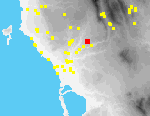 B01
Hora Kalianesi
B01
Hora Kalianesi
Tile: HL-R
Site B1 is located in a small overgrown vineyard on the western slopes of a small spur,[095.12] ca. 750 m. S of the outskirts of the modern town of Hora; the spur slopes W and N into a shallow valley, on the other side of which is the church of Ayios Nikolaos at Kavalaria (Site B2).
When the site was first discovered in 1992, it had been recently plowed and new vines planted.[003.08] Stones dislodged by plowing and hoeing had been gathered in piles by farmers. In 1995 the vineyard was overgrown and few artifacts were visible.
In the stone piles were two large worked slabs (max. pres. dim.: 0.62 W. x 0.5 L. x 0.11 Th.; 0.7 W. x 0.54 H. x 0.15 Th.), both with dowel holes (4 x 4 cm.) on one side (three on the first slab, two on the second).[003.09] Both appear to be spolia from the Palace of Nestor, reused as cover slabs for graves. Human bone was found in several places, and previously the farmers had themselves collected large fragments of a skull and human long bones.
The ceramic finds range in date from Classical to Early Modern, with an emphasis on the (Hellenistic-)Roman period. Ceramic finds, including vessel fragments and tiles, dating to the Roman and Hellenistic periods were collected [from grid squares 111, 211, 212, 311, 322, and 421]. Sherds from the Byzantine and Turkish periods were collected [in 111, 112, 222, and 321]. These sherds are mostly cooking wares. Few fine wares are represented in the collection. Hellenistic-Roman roof tiles were collected [in grid squares 111, 112, 311]. Later roof tiles were collected [in 411].